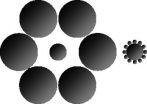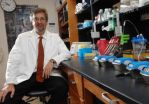(Press-News.org) VIDEO:
Saumil Gandhi, an M.D./Ph.D. candidate at Albert Einstein College of Medicine, discusses his new research which finds that, contrary to what researchers have assumed, genes that work with other genes...
Click here for more information.
December 5, 2010 ─ (BRONX, NY) ─ Scientists at Albert Einstein College of Medicine of Yeshiva University have made an unexpected finding about the method by which certain genes are activated. Contrary to what researchers have traditionally assumed, genes that work with other genes to build protein structures do not act in a coordinated way but instead are turned on randomly. The surprising discovery, described in the December 5 online edition of Nature Structural and Molecular Biology, may fundamentally change the way scientists think about the way cellular processes are synchronized.
All cells contain protein complexes that perform essential functions, such as producing energy and helping cells divide. Assembling these multi-protein structures requires many different genes, each of which codes for one of the proteins that, collectively, form what's known as the protein complex. Ribosomes, for example, are the vitally important structures on which proteins are synthesized. (The ribosomes of humans and most other organisms are composed of ribonucleic acid (RNA) and 80 different proteins.) Scientists have long assumed that genes involved in making such complex structures are activated in a highly-coordinated way.
"What we found was rather astonishing," said Robert Singer, Ph.D., professor and co-chair of anatomy and structural biology, professor of cell biology and of neuroscience at Einstein and senior author of the study. "The expression of the genes that make the protein subunits of ribosomes and other multi-protein complexes is not at all coordinated or co-regulated. In fact, such genes are so out of touch with each other that we dubbed them "clueless" genes."
Gene expression involves transcribing a gene's deoxyribonucleic acid (DNA) message into molecules of messenger RNA, which migrate from the nucleus of a cell into the surrounding cytoplasm to serve as blueprints for protein construction. To assess the coordinated expression of particular genes, Dr. Singer and his colleagues measured the abundance of messenger RNA molecules transcribed by those genes in individual cells. The messenger RNA molecules made by clusters of clueless genes exhibited no more coordination than the messenger RNA from totally unrelated genes did.
The "clueless" genes coding for ribosomes and other multi-protein structures are referred to as housekeeping genes, since their essential tasks require them to be "on call" 24/7, while other gene clusters remain silent until special circumstances induce them to become active. The researchers found that these induced genes, in contrast to the "clueless" housekeeping genes, act in an expected (well-regulated) way. For example, growing yeast cells in nutrient media containing the sugar galactose triggered the highly-coordinated expression of the three genes required to metabolize galactose.
"Our findings show that for a major class of genes – those housekeeping genes that make ribosomes, proteasomes and other essential structures – cells employ very simple modes of gene expression that require much less coordination than previously thought," said Saumil Gandhi, the lead author of the study. "Those genes become active randomly, with each member of a functionally related gene cluster encoding a protein while having no clue what the other genes in the cluster are doing. Yet the cell somehow manages to deal with this randomness in successfully assembling these multi-protein complexes."
The paper, "Transcription of functionally related constitutive genes is not coordinated," appears in the December 5 online edition of Nature Structural and Molecular Biology.
INFORMATION:
Albert Einstein College of Medicine of Yeshiva University is one of the nation's premier centers for research, medical education and clinical investigation. During the 2009-2010 academic year, Einstein is home to 722 M.D. students, 243 Ph.D. students, 128 students in the combined M.D./Ph.D. program, and approximately 350 postdoctoral research fellows. The College of Medicine has 2,775 fulltime faculty members located on the main campus and at its clinical affiliates. In 2009, Einstein received more than $155 million in support from the NIH. This includes the funding of major research centers at Einstein in diabetes, cancer, liver disease, and AIDS. Other areas where the College of Medicine is concentrating its efforts include developmental brain research, neuroscience, cardiac disease, and initiatives to reduce and eliminate ethnic and racial health disparities. Through its extensive affiliation network involving five medical centers in the Bronx, Manhattan and Long Island - which includes Montefiore Medical Center, The University Hospital and Academic Medical Center for Einstein - the College of Medicine runs one of the largest post-graduate medical training programs in the United States, offering approximately 150 residency programs to more than 2,500 physicians in training. For more information, please visit www.einstein.yu.edu
Wellcome Trust scientists have shown for the first time that exactly how we see our environment depends on the size of the visual part of our brain.
We are all familiar with the idea that our thoughts and emotions differ from one person to another, but most people assume that how we perceive the visual world is usually very similar from person to person. However, the primary visual cortex – the area at the back of the brain responsible for processing what we see in the world around us – is known to differ in size by up to three times from one individual to the next.
Now, ...
Climate change is causing wildfires to burn more fiercely, pumping more greenhouse gases into the atmosphere than previously thought, according to a new study to be published in Nature Geosciences this week.
This is the first study to reveal that fires in the Alaskan interior - an area spanning 18.5 million hectares - have become more severe in the past 10 years, and have released much more carbon into the atmosphere than was stored by the region's forests over the same period.
"When most people think of wildfires, they think about trees burning, but most of what fuels ...
For years, geologists have argued about the processes that formed steep inner gorges in the broad glacial valleys of the Swiss Alps.
The U-shaped valleys were created by slow-moving glaciers that behaved something like road graders, eroding the bedrock over hundreds or thousands of years. When the glaciers receded, rivers carved V-shaped notches, or inner gorges, into the floors of the glacial valleys. But scientists disagreed about whether those notches were erased by subsequent glaciers and then formed all over again as the second round of glaciers receded.
New ...
Damage caused by multiple sclerosis could be reversed by activating stem cells that can repair injury in the central nervous system, a study has shown.
Researchers from the Universities of Cambridge and Edinburgh have identified a mechanism essential for regenerating insulating layers – known as myelin sheaths – that protect nerve fibres in the brain. In additional studies in rodents, they showed how this mechanism can be exploited to make the brain's own stem cells better able to regenerate new myelin.
In multiple sclerosis, loss of myelin leads to the nerve fibres ...
Sugar molecules coat every cell in our bodies and play critical roles in development and disease, yet the components of these "glycans" have been difficult for scientists to study, because of their complexity.
Researchers at Emory University School of Medicine have adapted gene chip microarray technology to the study of glycans, with an approach they call "shotgun glycomics." The Emory team has developed a new chemical method for attaching a fluorescent dye to glycans purified from cells. The individual glycans are separated into tiny spots fixed to glass slides.
The ...
On November 19, Jason Martin returned to the Medical Intensive Care Unit (MICU) at Vanderbilt University Medical Center for the first time since he nearly died there during last year's H1N1 flu pandemic. The tall and burly Warren County, TN, ambulance worker – a 30-year-old, father of three young children – broke down and hugged some of the nurses he recognized.
"I got sick on September 12 and didn't come out of it for the next 20 days. I am just so grateful I came through," Martin said, wiping his eyes.
Martin was among the first wave of critically ill middle Tennesseans, ...
SALT LAKE CITY, Dec. 6, 2010 – Four years after the LouseBuster prototype made headlines when research showed the chemical-free, warm-air device wiped out head lice on children, a new study reveals that a revamped, government-cleared model is highly effective.
"For a louse, it's like sticking your head out a window at 100 miles an hour; they're going to get dried out," says University of Utah biology Professor Dale Clayton, senior author of the study and a founder of Larada Sciences, a university spinoff company that sells or leases the LouseBuster to schools, ...
For the first time, researchers have established a clear link between accepting family attitudes and behaviors towards their lesbian, gay, bisexual and transgender (LGBT) children and significantly decreased risk and better overall health in adulthood. The study shows that specific parental and caregiver behaviors -- such as advocating for their children when they are mistreated because of their LGBT identity or supporting their gender expression -- protect against
depression, substance abuse, suicidal thoughts and suicide attempts in early adulthood. In addition, LGBT ...
COLUMBUS, Ohio – The U.S. Fish and Wildlife Service is excluding significant research findings about human threats to protected species, researchers argue, even when the law governing the agency's actions requires the use of all relevant data in determining whether species need protection from extinction.
A group of scientists, led by Jeremy Bruskotter of Ohio State University, argue in the December issue of the journal BioScience that research about societal values should be considered along with biological and ecological data in listing decisions.
The Endangered Species ...
Nonindigenous insects and pathogens continue to become established in US forests with regularity despite regulations intended to prevent this, according to a study published in the December 2010 issue of BioScience. The study, by a team led by Juliann E. Aukema of the National Center for Ecological Analysis and Synthesis in Santa Barbara, California, found that nonindigenous insects are being newly detected in US forests at a rate of about 2.5 per year, and high-impact insects and pathogens that cause significant effects in forests, including tree death, are being newly ...




